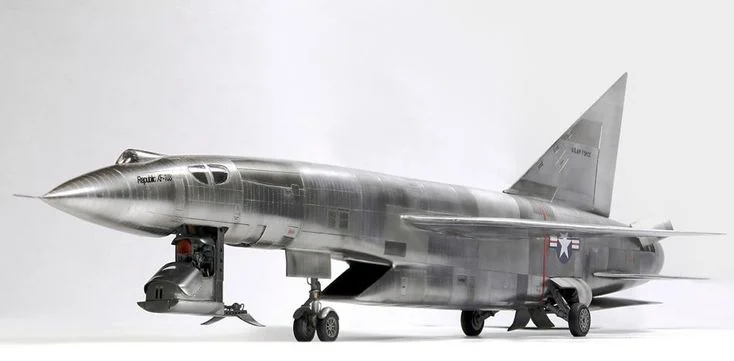✈️ Republic XF-103 Thunderwarrior — Review
🧩 Overview
The Republic XF-103 Thunderwarrior was a proposed high-speed, high-altitude interceptor designed in the 1950s by Republic Aviation for the U.S. Air Force. Its mission was to intercept and destroy Soviet nuclear bombers before they could reach American airspace.
It was never completed or flown — but its specs were wildly ambitious for its time. With a Mach 3 top speed, titanium construction, internal weapons bays, and a cockpit ejection capsule, it looked more like a spacecraft than a jet.
⚙️ Specifications (Planned)
-
First design year: 1951
-
Status: Canceled before first flight
-
Crew: 1
-
Length: 84 ft (25.6 m)
-
Wingspan: 39 ft (11.9 m)
-
Estimated top speed: Mach 3.7 (around 2,500+ mph)
-
Service ceiling: ~80,000 ft (24,400 m)
-
Range: ~1,000 miles (1,600 km)
-
Engines:
-
1 × Wright J67 turbojet (derivative of the Bristol Olympus)
-
Integrated ramjet for high-speed performance
-
🛠 Design Highlights
-
Titanium construction to survive extreme heat from Mach 3+ flight
-
Internal weapons bay for nuclear-tipped air-to-air missiles (GAR-9/AIM-47)
-
Ejection capsule instead of a traditional ejection seat — it would detach entirely in emergencies
-
Razor-sharp delta wing design with small control surfaces
-
Intended to use combined cycle propulsion: turbojet for takeoff, ramjet for supersonic cruise
🚫 Why It Was Canceled
Despite its ambitious goals, the XF-103 never got past the mock-up and component testing stages. Major reasons for cancellation:
-
The J67 engine never matured
-
Ramjet technology wasn’t ready
-
Extremely high development costs
-
Changing defense doctrine — ICBMs were replacing bombers as the primary nuclear threat
By the mid-1950s, the need for high-speed manned interceptors was already fading.
🧱 Strengths (on paper)
-
Would have been one of the fastest aircraft in the world
-
Advanced avionics and radar for long-range interception
-
Internal missile carriage for reduced drag
-
Designed to counter Soviet Tu-95 Bear bombers at long distances
⚠️ Weaknesses
-
Never flew — unproven in every way
-
Required extremely complex engineering (e.g., dual-engine propulsion, heat shielding)
-
Outpaced by advances in missile defense and satellite surveillance
-
Would have been expensive and hard to maintain
🏁 Final Verdict
| Category | Rating (★ out of 5) |
|---|---|
| Innovation | ★★★★★ |
| Feasibility | ★★☆☆☆ |
| Combat Potential | ★★★★☆ (Theoretical) |
| Cool Factor | ★★★★★ |
| Legacy | ★★★☆☆ |
🔚 Final Thoughts
The XF-103 Thunderwarrior represents the peak of 1950s American jet ambition — an aircraft built for a nuclear world where speed and altitude were everything. Though it never flew, it remains a fascinating “what-if” of Cold War aviation, influencing ideas that would later emerge in the SR-71 and modern stealth fighters.

Comments are closed